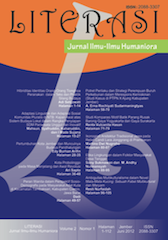IKONOGRAFI ARSITEKTUR TRADISIONAL JAWA PADA RELIEF CANDI LARA JONGGRANG DI PRAMBANAN
Abstract
One way to know the characteristics of traditional Javanese architecture is by looking at pictorial data found in the reliefs of temple buildings. The Lara Jonggrang temple contains a symbolic meaning. In general, the type of roof on the temple reliefs is rural type. The roof construction composed of a series of components called battens, standing on beam, and rafters. Most of the houses have no walls. Wooden buildings on the reliefs show the use of the functional requirements of geography, geology, and climate. The birds are always perched on the roof of building of the reliefs with the settings under the palace and hermitage with central figures such as Rama, Shinta adding a dramatic impression. House placement with a bird perched on the roof which is always placed at the top of each relief indicates a status. This also suggests that in the days of the Central Java Hindus, house was a status symbol and the placement of the house there served only as reliefs featuring characters of high strata.
Keywords: iconography, traditional Javanese architecture, reliefs temple


